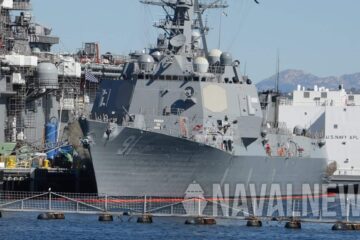After the ceremony, the ship will transit to join Littoral Combat Ship Squadron 1 and ten other littoral combat ships currently homeported at Naval Base San Diego.
“I will bring up all four engines online, come to full power, and steam right at you with that gun blazing and my eventual missiles launching. Charleston will not turn and run. We will not run because while we breathe, we fight!”
Cmdr. Christopher K. Busca, USS Charleston’s commanding officer
Littoral combat ships are high speed, agile, shallow draft, mission-focused surface combatants designed for operations in the littoral environment, yet fully capable of open ocean operations. As part of the surface fleet, littoral combat ships have the ability to counter and outpace evolving threats independently or within a network of surface combatants. Paired with advanced sonar and mine hunting capabilities, the littoral combat ships provide a major contribution, as well as a more diverse set of options to commanders, across the spectrum of operations.

The LCS class consists of two variants, the Freedom variant and the Independence variant, designed and built by two industry teams. The Independence variant team is led by Austal USA, Mobile, Alabama, (for LCS 6 and the subsequent even-numbered hulls). The Freedom variant team is led by Lockheed Martin, Marinette, Wisconsin, (for the odd-numbered hulls).
USS Tulsa will join USS Freedom (LCS 1), USS Independence (LCS 2), USS Fort Worth (LCS 3), USS Coronado (LCS 4), USS Jackson (LCS 6), USS Montgomery (LCS 8), USS Gabrielle Giffords (LCS 10), USS Omaha (LCS 12), USS Manchester (LCS 14) and USS Tulsa (LCS 16) in their homeports of San Diego.






